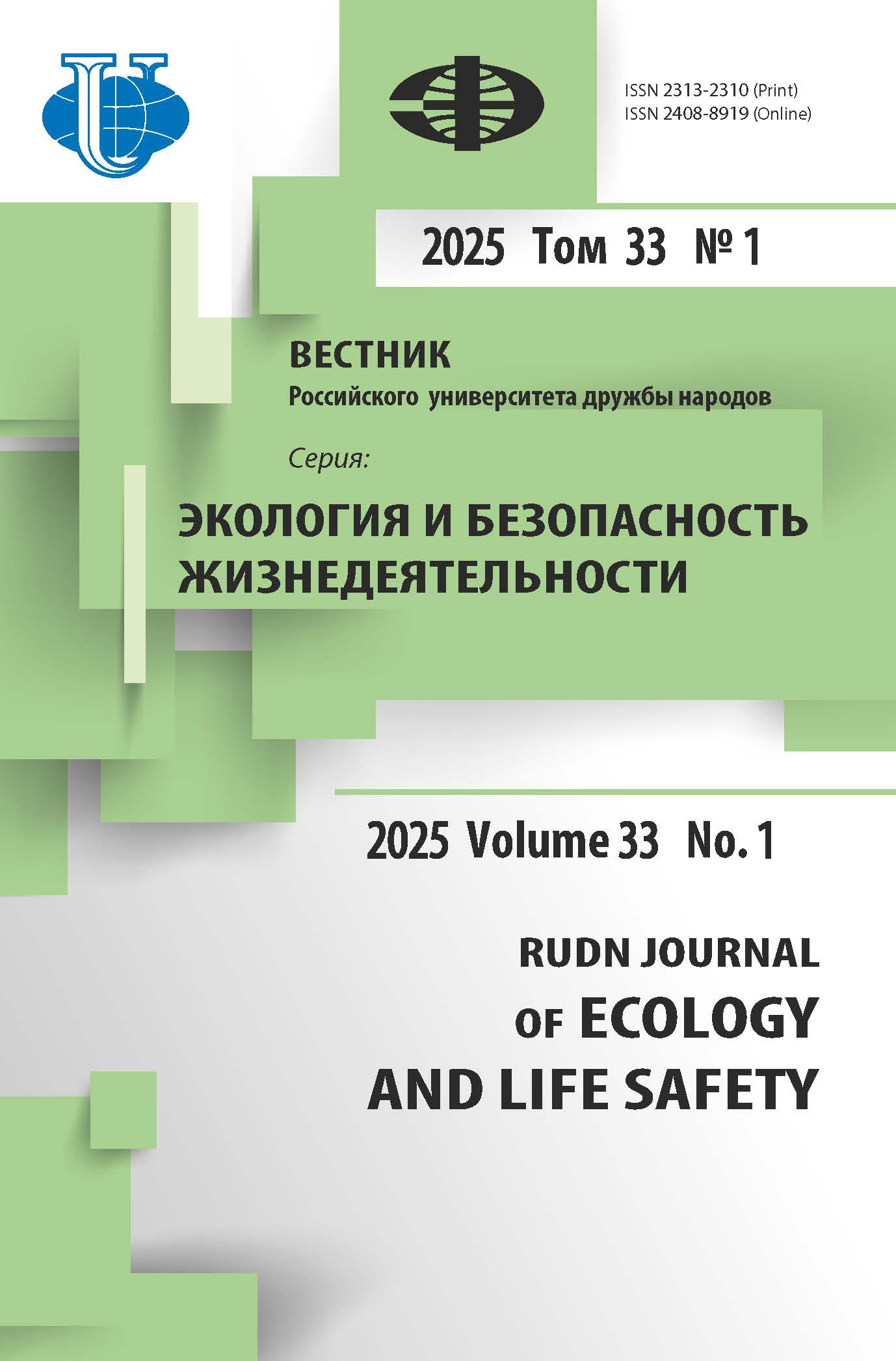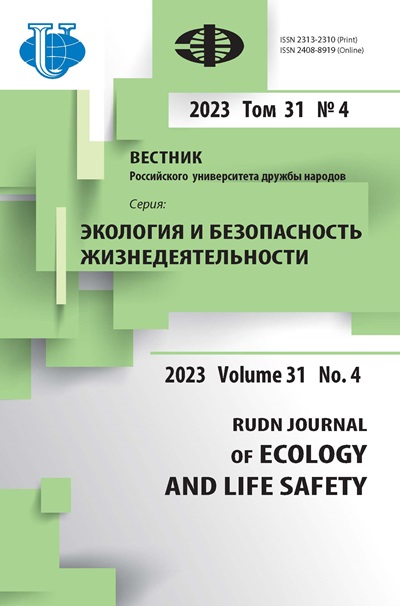Evaluation of the effect of antibiotics on the growth reactions of higher plants - potential phytoremediants
- Authors: Timofeeva S.S.1, Tyukalova O.V.1, Timofeev S.S.1
-
Affiliations:
- Irkutsk National Research Technical University
- Issue: Vol 31, No 4 (2023)
- Pages: 556-571
- Section: Biological resources
- URL: https://journals.rudn.ru/ecology/article/view/37588
- DOI: https://doi.org/10.22363/2313-2310-2023-31-4-556-571
- EDN: https://elibrary.ru/RYFCYA
Cite item
Full Text
Abstract
The relevance of the work is due to the need to study the assessment of the toxicity of antimicrobial drugs for environmental objects. The simplest and most obvious methods of assessing the impact of antibiotics on the environment are bioindication methods, in particular, the assessment of phytotoxicity of drugs. The study presents the results of the analysis of the cytotoxic effect of antibiotics of different nature in relation to herbaceous plants of various systematic groups in a laboratory experiment. The phytotoxic effect of the considered antibiotic samples was determined by comparing the indicators of the test function of the seeds of the control and experimental groups. The dependence of the magnitude of the phytotoxic effect on the pharmaceutical group of the antibiotic is shown. The data obtained are the basis for further research to assess the negative impact on the environment and the development of technologies for phytoremediation of environmental objects. The purpose of this work was to evaluate the effect of antibiotics on the growth reactions of higher plants - potential phytoremediants.
Keywords
About the authors
Svetlana S. Timofeeva
Irkutsk National Research Technical University
Author for correspondence.
Email: sstimofeeva@mail.ru
ORCID iD: 0000-0001-8427-3732
SPIN-code: 8427-9622
D. of Technical Sciences, Professor, Head of the Department of Industrial Ecology and Life Safety
83 Lermontova St, Irkutsk 664074, Russian FederationOlga V. Tyukalova
Irkutsk National Research Technical University
Email: olgaburlak1@yandex.ru
ORCID iD: 0000-0002-2464-261X
SPIN-code: 6806-7565
Candidate of Chemical Sciences, Associate Professor of the Department of Industrial Ecology and Life Safety
83 Lermontova St, Irkutsk 664074, Russian FederationSemyon S. Timofeev
Irkutsk National Research Technical University
Email: sstimofeeva@mail.ru
ORCID iD: 0000-0001-7085-9468
SPIN-code: 2694-7070
Senior Lecturer of the Department of Industrial Ecology and Life Safety
83 Lermontova St, Irkutsk 664074, Russian FederationReferences
- Barenboim GM. Pollution of natural waters by medicines. Moscow: Nauka; 2015. (In Russ.)
- Vodyanitskii YuN, Yakovlev AS. Contamination of soils and soil-groundwater with new organic micro pollutants. Soil Science. 2016;5:609–619. (In Russ.)
- Kukec VG, Sychev DA (eds.) Clinical pharmacology. 6th ed. Moscow: GEHOTAR-Media, 2021. (In Russ.)
- Kraemer SA, Ramachandran A, Perron GG. Antibiotic pollution in the environment: from microbial ecology to public policy. Microorganisms. 2019;7:180. http://doi.org/10.3390/microorganisms7060180
- Zheng D, Yin G, Liu M, Chen C, Jiang Y, Hou L, et al. A systematic review of antibiotics and antibiotic resistance genes in estuarine and coastal environments. Science of The Total Environment. 2021;777(2):146009. http://doi.org/10.1016/j.scitotenv. 146009
- De Carvalho JF, Moraes JEF. Treatment of simulated industrial pharmaceutical wastewater containing amoxicillin antibiotic via advanced oxidation processes. Environmental Technology. 2021;42(26):4145–4157. http://doi.org/10.1080/09593330. 2020.1745296
- Rooklidge SJ. Enviromental antimicrobial contamination from terraccumulation and diffuse pollution pathways. Science of the Total Enviroment. 2004;325:1–13. http://doi.org/10.1016/j.scitotenv.2003.11.007
- Zhu YG, Johnson TA, Su JQ, Qiao M, Guo GX, Stedtfeld, RD, et al. Diverse and abundant antibiotic resistance genes in chinese swine farms. PNAS. 2013;110(9):3435‒3440. http://doi.org/10.1073/pnas.1222743110
- Datta R, Das P, Smith S, Punamiya P, Ramanathan DM, Reddy R, Sarkar D. Phitoremidiation potential of vetiver grass [Chrisopogon zizanioides (L.)] for tetracycline. Int J Phytoremidiation. 2013;15(4):343–351. http://doi.org/10.1080/ 15226514.2012.702803
- Rodriguez-Mozaz S, Chamorro S, Marti E, Huerta B, Gros M, Sànchez-Melsió, A, et al. Occurrence of antibiotics and antibiotic resistance genes in hospital and urban wastewaters and their impact on the receiving river. Water Research. 2015;69:234‒242. http://doi.org/10.1016/j.watres.2014.11.021
- Danner M-C, Anne Robertson A., Volker Behrends V., Reiss J. Antibiotic pollution in surface fresh waters: Occurrence and effects. Science of The Total Environment. 2019;664(10):793–804. https://doi.org/10.1016/j.scitotenv.2019.01.406
- Boxall А, Wilkinson J. Identifying hotspots of resistance selection from antibiotic exposure in urban environments around the world. SETAC Europe 29th Annual Meeting, Helsinki, Finland. May 27, 2019.
- Zhi C, Zhou J, Yang F, Tian L, Zhang K. Systematic analysis of occurrence and variation tendency about 58 typical veterinary antibiotics during animal wastewater disposal processes in Tianjin, China. Ecotoxicology and Environmental Safety. 2018;165:376–385. http://doi.org/10.1016/j.ecoenv.2018.08.101
- Zhang Y, Wang B, Cagnetta G, Duan L, Yang J, Deng S, et al. Typical pharmaceuticals in major WWTPs in Beijing, China: Occurrence, load pattern and calculation reliability. Water Research. 2018;140:291–300. http://doi.org/10.1016/j.watres.2018.04.056
- Li Z, Zheng T, Li M, Liu X. Organic contaminants in the effluent of Chinese wastewater treatment plants. Environmental Science and Pollution Research. 2018;25:26852–26860. http://doi.org/10.1007/ s11356-018-2840-2
- Zhanga M, Liu Y, Zhao J, Liu W, He L, Zhang J, et al. Occurrence, fate and mass loadings of antibiotics in two swine wastewater treatment systems. Science of the Total Environment. 2018;639:1421–1431. http://doi.org/10.1016/j.amjcard.2008.02.056
- Williams M, Kookana RS, Mehta A, Yadav SK, Tailor BL, Maheshwari B. Emerging contaminants in a river receiving untreated wastewater from an Indian urban centre. Science of the Total Environment. 2019;647:1256–1265. http://doi.org/10.1016/ j.scitotenv.2018.08.084
- Shuvarin MV, Borisova EE, Ganin DV, Shuvarina NA, Lekhanov IA. Экологические проблемы утилизации отходов животноводства. Vestnik NGIEI. 2020;4(107):101–112. http://doi.org/10.24411/2227-9407-2020-10068
- Galchenko DS, Smirnova MG, Sokolova LI. Using natural aluminosilicate (vermiculite) sorbent for purifying waste water from antibiotics. XXI Century. Technosphere Safety. 2021;6(4):387–394. https://doi.org/10.21285/2500-1582-2021-4-387-394. (In Russ.)
- Sokolova LI, Gal’chenko DS, Smirnova MG, Blinovskaya YaYu. Using of natural aluminosilicates for clean wastewater from antibiotics various classes. Gidrometeorologiya i Ekologiya. Journal of Hydrometeorology and Ecology (Proceedings of the Russian State Hydrometeorological University). 2021;62:113–126. http://doi.org/10.33933/2074-2762-2021-62-113-126 (In Russ).
- Novikova YuA, Markova OL, Fridman KB. The main directions of minimizing risks to public health caused by contamination of surface sources of drinking water supply with drugs. Gigiena i sanitariya. 2018;97(12):1166–1170. http://dx.doi.org/10.18821/0016-9900-2018-97-12-1166-1170. (In Russ).
- Timofeeva SS, Shupletsova ID. Forecasting environmental risks of micro-pollutants in the Baikal region. XXI century. Technosphere safety. 2020;5(3):269–283. https://doi.org/10.21285/2500-1582-2020-3-269-283 (In Russ.).
- Timofeeva SS, Gudilova OS. Antibiotics in the environment: state and problems. XXI century. Technosphere safety. 2021;6(3):251–265. https://doi.org/10.21285/2500-1582-2021-3-251-265 (In Russ.).
- Timofeeva SS, Timofeev SS, Tyukalova OV. Assessment of potential risks to the health of the population of the Baikal region when using products contaminated withantibiotics. RUDN Journal of Ecology and Life Safety. 2022;30(3):312–325. http://doi.org/10.22363/2313-2310-2022-30-3-312-325. (In Russ.).
- Chesnokova SM, Savel'ev OV. Assessing the antibiotic resistance of various groups in water environment through biotesting. International Research Journal. 2020;9–1(99):101–110. https://doi.org/10.23670/IRJ.2020.99.9.018. (In Russ.).
- Egorov NS. Fundamentals of learning about antibiotics. 6th ed. Moscow: Izd. MGU. Nauka; 2004. (In Russ.).

















